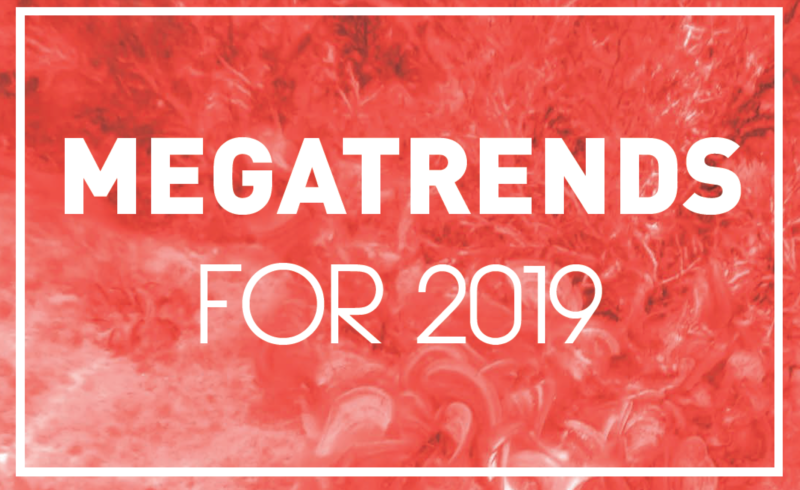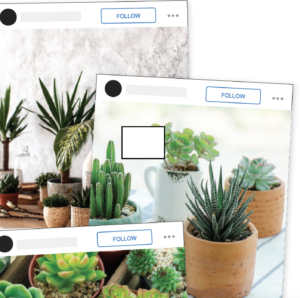
Marketing & Trends — Megatrends for 2019
To better understand consumer thinking, the Produce Marketing Association (PMA) recently turned to market researcher Euromonitor International for insights on megatrends. There’s a new “me” mindset that’s taken over — one dominated by well-being, a new take on value, and a desire to have a lower impact on the environment.
It’s our collective job to parlay these trends and insights from researchers, thought leaders and influencers to capitalize on consumer behaviors and maximize plant and floral sales.
PREMIUMIZATION
According to Euromonitor, consumers will spend more on what matters to them, while cutting back on what doesn’t. In today’s world of premiumization, consumers are investing in themselves, and their homes, to feel healthier, content and more relaxed.
The good news for the industry? An easy way to indulge is gifting yourself, a friend or family member with plants and flowers. Cut flowers and ornamentals, including potted green, flowering, vegetable, herb and fruit plants, can complete home, garden and special-occasion décor.
The industry has blossomed. Major contributing factors? Social media and millennials.
By 2020, millennials will make up 34 percent of the global population. Many are social media influencers in areas like fashion, home décor, and lifestyle who feature plants and flowers in their feeds. Known as plant parents, they share advice on how to style and photograph plants.

In a recent article in the UK-based Independent, writer Penelope Green described millennials’ “obsession with houseplants as growing faster and more tenaciously than English ivy … Plant influencers, the horticultural stars of [Instagram],” she writes, “have book deals, sponsors and hundreds of thousands of followers.”
Photos of houseplants are the new food on Instagram, she says. This creates a visual story that entices lifestyle envy. Indeed, plants are extra, like guacamole.
In her State of the Industry address at the 2018 Fresh Summit, PMA CEO Cathy Burns made note of this trend. “Our own research into the floral consumer found that millennials are a key target for plants and floral because they engage more with experiential products and live in the moment — especially on social media platforms like Snapchat and Instagram. Their concerns for the environment and planet will also play a role in continued floral growth.”
Digital and consumer media even publish “plantspiration” shopping guides and lists of best plants for college students and dorms. Members of Generation Z who subscribe to the premiumization megatrend use their purchasing power, and their décor dollars, to buy plants.
But this trend isn’t limited to the younger generations. Joanna Gaines, the famed HGTV designer, home décor and lifestyle influencer is also a plant lady.
On her Magnolia blog Gaines says, “What’s my absolute favorite part of finishing up a Fixer Upper project? That’s easy — adding plants. … To me, plants bring a space to life, and that is one of the best parts of personalizing a home for my clients.”
Heading into 2019, consider making premiumization part of your strategy. The feeling of being on trend, exclusivity, and being worthy of a little affordable indulgence are powerful consumer motivators.
HEALTHY LIVING
Consumers are more inward focused, demonstrating a holistic approach to wellness that encompasses spiritual, mental and physical well-being. This provides the industry with opportunities to differentiate brands by weaving health into marketing.
According to researchers at Texas A&M, people who keep flowers and/or plants in their home feel happier, less stressed and more relaxed.
Being around plants helps them to concentrate better in the home and workplace.
PMA research indicates younger customers also buy floral products to celebrate their personalities and express moods. Color also can create a mood and a respite.
Since 2016, PMA has partnered with the Pantone Color Institute to provide a webinar on color trends insights that includes color palettes and color-think questions you can use as inspiration for engaging customers and increasing sales.
Pantone’s 2017 Color of the Year was Greenery, with green hues considered natural, organic and healthy. The color continues to show up in interiors. Pantone described Ultra Violet, the 2018 Color of the Year, as a dramatic color that communicates originality, ingenuity, and visionary thinking associated with mindfulness practices that offer solace to those seeking to step back from hectic lifestyles.
Life is still hectic, so how does this bode for future color and consumer trends?
Last month, Pantone unveiled the nature-inspired Living Coral as the Color of the Year for 2019 (see photo above). This color brings comfort and familiarity to uplift us and make us feel good, says Pantone. It’s “a shade that affirms life through a dual role of energizing and nourishing … and reinforces how colors can embody our collective experience and reflect what is taking place in our global culture at a moment in time.”
To capitalize on this healthy-living trend and need for nourishment, retailers might consider exploring creative and engaging ways to emphasize the benefits of plants and flowers beyond their aesthetic or aromatic value.
Look for more color inspiration from Pantone during PMA’s free webinar scheduled for March 28. Pantone will share its newest color palette and other insights. Visit www.pma.com to register.
ETHICAL LIVING
Consumers are paying more attention to ethics and moral values of companies. This includes concerns about the environment, sustainability, production, labor practices and community outreach, according to Euromonitor.
Sustainability certification for floriculture ensures that farms provide safe, healthy and equitable work environments. As consumers become more socially and environmentally concerned, so will growers, according to PMA’s Glimpse report. Farms will continue to move away from “red-label” chemicals, while certifications from the Rainforest Alliance and fair-trade groups will become more commonplace.
PMA does not provide sustainability certification, but this past summer we unveiled the Ethical Charter for Responsible Labor Practices, a joint initiative with United Fresh Produce Association.
The Charter provides a baseline for accountability and transparency that can be widely understood, accepted and applied across the global floral and produce supply chains. For more information on the Charter, visit www. ethicalcharter.com.
PMA research indicates the industry will continue to seek efficiencies in the supply chain. In the U.S., farmers will seek to bypass the conventional wholesale pipeline and market directly to supermarkets, big box retailers and consumers. This is becoming a reality with e-commerce.
Thanks to the farm-to-table movement, some independent chains and small grocers are responding to customers’ calls to do the same with their floral merchandise. These requests are based on customers’ requests for transparency, concern for environmental issues and ethical sourcing, according to PMA’s report “Trends in Mass Market Floral.”
Urban gardens, big and small, containerized, potted, or in field, will continue to grow in popularity as the locally grown movement increases in popularity, according to PMA’s Glimpse report. This will provide an opportunity to increase sales in potted herbs, vegetables and flowering plants.
In addition, consumers’ desire for container gardens with scaled-down versions of easy-care plants is part of a larger back-to-basics-with-a-twist trend where there’s more emphasis on large pots filled with a single, impressive statement plant.
MIDDLE CLASS RETREAT AND SHIFTING MARKET FRONTIERS
Euromonitor asserts that while the middle class will boom in Asia, in developed markets like the United States and European Union they will struggle to maintain their economic position.
The middle class is described as celebrating how little something costs. To win the middle class in developed countries, our industry needs to emphasize quality and look for a new take on value. There must be a balancing act between premiumization and price.
Our industry must adapt to changing demographics, economics and technologies bringing new markets to the spotlight. Also, as some geographic regions reach their maximum potential, others will gain prominence for their unexploited potential.
While e-commerce is growing, most floral and plant sales are still taking place in stores. Convenience and ability to shop at stores that close at 10 p.m. or at 24-hour markets are a draw.
Ongoing access to sales data should help both retailers and suppliers make informed decisions about what’s popular. Last year, PMA, working with our Floral Council, identified the need for such aggregated point-of-sale data. Working with data aggregators, the industry can now access such floral purchasing data across U.S. supermarkets.
Big data and behavior-based analysis will lead to greater personalization, signaling the end of demographic-based marketing tactics according to 10ecommercetrends.com. Artificial intelligence is allowing us to create customized consumer experiences, which means millennials will likely be the last to be marketed to as a generation.
In addition to consumer megatrends, tech megatrends also will influence the mass-market floral industry. We will continue seeing more selling via social media and messaging, internet-enabled subscriptions and other innovative methods.
In a marketplace where botanists, growers and crackerjack home gardeners can become Instagram influencers who sell plants and flowers from their small farms, apartments, or in pop-up stores, we need to be nimble, creative and responsive to customer needs and wants.
Trend research tells us that plants, produce and flowers are white hot in culture right now; let’s make the most of it!


 Video Library
Video Library 



















